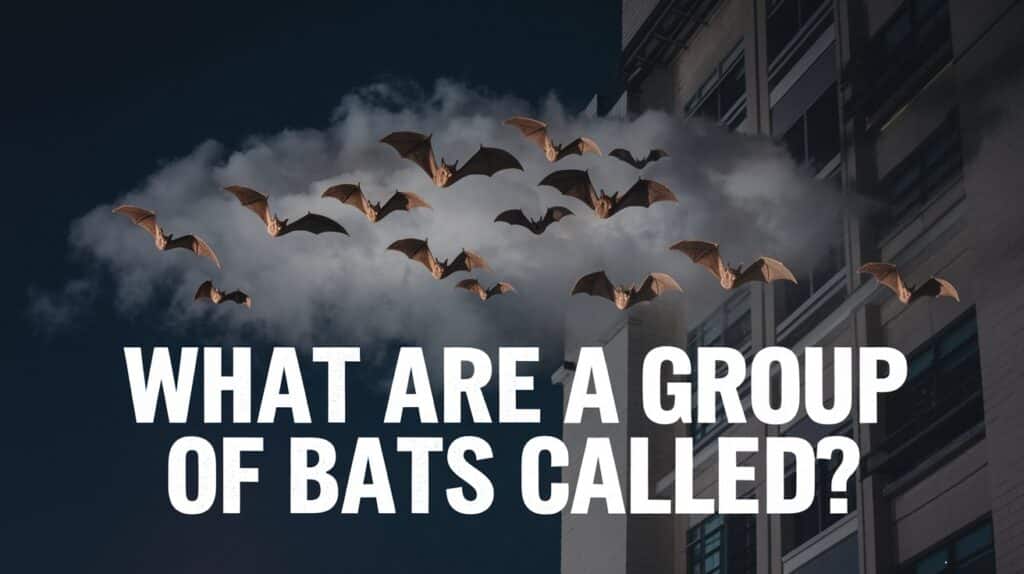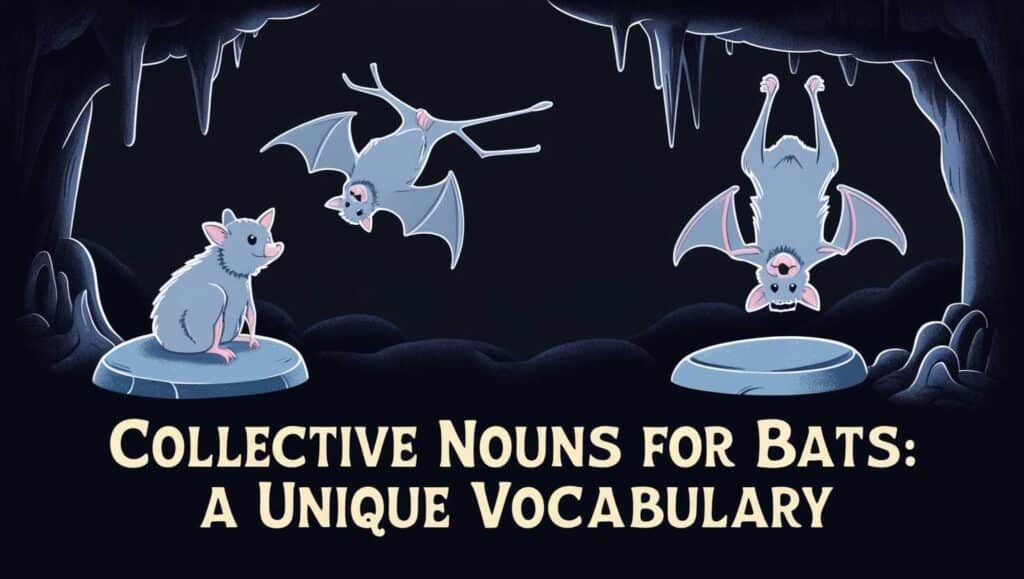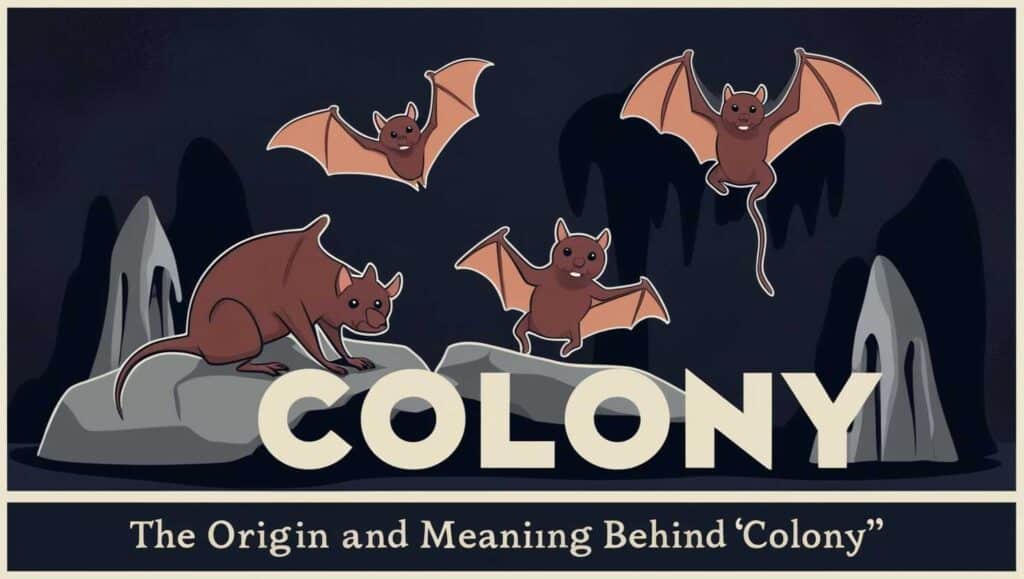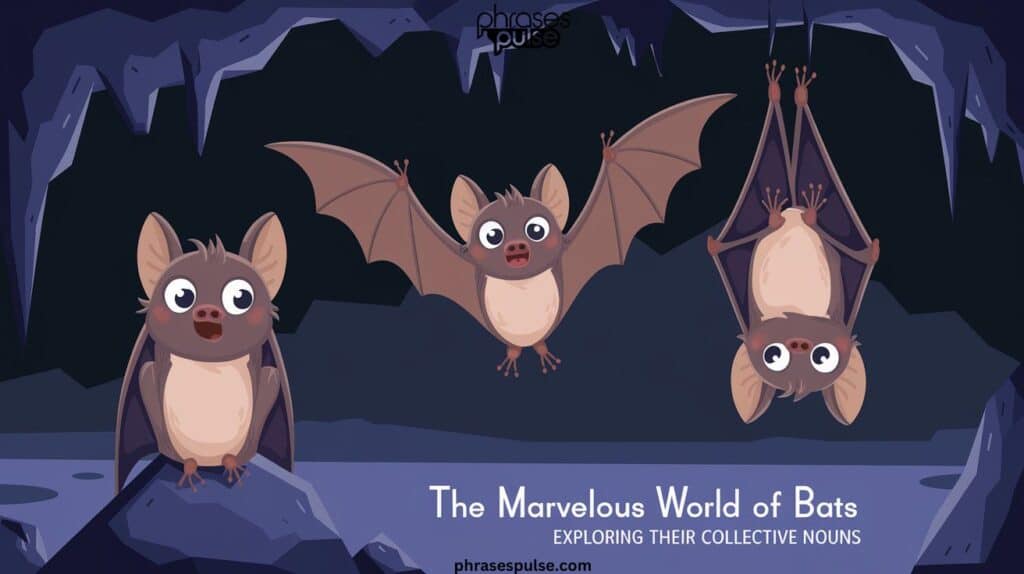Collective noun for bats is just as intriguing as the creatures themselves. These fascinating nocturnal mammals play a vital role in nature, often forming groups both in flight and while roosting. Despite their importance, bats often go unnoticed.
But have you ever wondered what we call these gatherings? Whether soaring through the night sky or huddling in colonies, the terms we use to describe bats in groups offer a unique glimpse into their mysterious world.
What Are a Group of Bats Called?

A group of bats is commonly called a colony, especially when they’re roosting together during the day. Bats form colonies for warmth, protection, and social interaction, with sizes ranging from just a few individuals to millions. In flight, they may be referred to as a cloud or cauldron, terms that capture their swirling, collective movement at dusk.
Bats exhibit strong social bonds within these groups, using echolocation to communicate and even sharing food with weaker members. These group dynamics help them navigate, hunt, and stay safe, showcasing their incredible adaptability and cooperation.
Bats: More Than Just Nighttime Flyers
Bats, the only mammals capable of sustained flight, are essential for maintaining ecological balance. These creatures pollinate plants, spread seeds, and control insect populations. Some species can eat up to 1,200 mosquitoes an hour! With over 1,400 bat species worldwide, they are diverse in size, behavior, and habitat.
Given their unique behaviors and social tendencies, several collective nouns have been assigned to describe groups of bats. These words offer a window into the mystery, magic, and ecology of bat colonies.
Collective Nouns for Bats: A Unique Vocabulary

A group of bats is called by various names, with each term capturing a different aspect of bat behavior or appearance. Whether you’ve heard of a colony of bats or a cloud of bats, these words evoke vivid imagery that helps us better understand bats. Let’s explore the most common collective nouns used to describe these nocturnal creatures.
| Noun | Description |
|---|---|
| Colony of Bats | Refers to a group of bats living together, typically in a roost. |
| Cauldron of Bats | Describes bats in flight, often swirling in large numbers, resembling a cauldron’s contents. |
| Cloud of Bats | A large group of bats flying together, creating a cloud-like appearance in the sky. |
| Swarm of Bats | Used when bats gather in large numbers, often during mating or feeding. |
| Flock of Bats | Similar to birds, this term is used when bats are flying in groups. |
| Camp of Bats | Refers to a roosting site, often used for large groups of bats. |
| Nightwatch of Bats | A poetic term, emphasizing bats as nighttime sentinels. |
| Cluster of Bats | Used for smaller groups of bats roosting together in tight formations. |
| Horde of Bats | Describes a large, chaotic group of bats, often in motion. |
| Flutter of Bats | Emphasizes the rapid wing movements and light flight patterns of bats. |
| Obscurity of Bats | A metaphorical term, highlighting the hidden, secretive nature of bats. |
| Veil of Bats | Refers to a thin, almost transparent group of bats in the air, moving like a veil. |
| Wing of Bats | Symbolizes bats in flight, focusing on their wings and flight capabilities. |
| Shadow of Bats | Suggests a dark, looming group of bats, often flying as night falls. |
| Chatter of Bats | Describes a group of bats producing vocalizations, especially when echolocating or communicating. |
Detailed Explanations collective noun for bats
The collective noun for bats varies by their behavior and context. A colony describes bats roosting together, while in flight, they can be called a cauldron or cloud. Each term reflects their social structure and mesmerizing aerial displays at dusk.
Colony of Bats
The most commonly used collective noun for bats is a “colony.” A colony of bats typically refers to a group that lives or roosts together in caves, trees, or buildings. This term accurately reflects their social nature, as bats often live in large, tightly-knit communities, particularly during the day when they rest in dark, safe environments.
Why the Word ‘Colony’?
The term “colony” is fitting because bats are social animals. They roost together in large groups for warmth, protection, and social interaction. Just like a bee colony or an ant colony, bat colonies are structured and organized. Each bat contributes to the well-being of the group, whether by grooming one another or using echolocation to navigate and hunt.
| Bat Colony Facts | Details |
|---|---|
| Average size of a colony | Can range from 100 to several million bats |
| Common roosting places | Caves, abandoned mines, hollow trees, attics |
| Role in the ecosystem | Insect control, seed dispersal, pollination |
Cauldron of Bats
When bats take to the skies at dusk, swirling in large groups, they form what is sometimes called a “cauldron.” The word cauldron of bats paints a vivid picture of bats swirling in a seemingly chaotic dance as they embark on their nightly hunt. This term evokes the mystical and often misunderstood nature of bats, which have long been associated with the supernatural.
Why ‘Cauldron’?
The swirling motion of bats in flight, especially when they emerge from a roosting site all at once, resembles the swirling contents of a cauldron. The term has a slightly eerie, magical feel to it, drawing on ancient associations between bats, night, and witchcraft.
“As twilight descends, the sky fills with a cauldron of bats, swirling and swooping in their nightly hunt for insects.”
Cloud of Bats
A cloud of bats is another term used to describe a group of bats in flight. This collective noun emphasizes the visual impact of large numbers of bats flying together at dusk or dawn, creating what looks like a dark cloud moving across the twilight sky.
The Science Behind Bat Clouds
Bats have incredible navigation skills thanks to echolocation, allowing them to fly in large groups without colliding. As they fly together, especially when leaving a cave or roost, their numbers can seem overwhelming, hence the term “cloud.” The term captures both the sheer number and fluid movement of bats in the air.
| Cloud of Bats Characteristics | Details |
|---|---|
| Common species seen in clouds | Mexican free-tailed bats, fruit bats |
| Typical size of a cloud | Can range from hundreds to thousands of bats |
| Why they fly in clouds | To avoid predators and enhance hunting efficiency |
Swarm of Bats
A swarm of bats refers to a large group of bats in frenzied motion, often during mating or feeding. This term captures the energy and activity of bats as they gather in large numbers, especially during migration or seasonal gatherings. While it’s not the most common collective noun for bats, “swarm” conveys the intense activity and large-scale movement of these creatures.
Flock of Bats
Though “flock” is more commonly associated with birds, the term can also be applied to bats, particularly when they are seen in large groups flying together. So, if you’ve ever wondered what is a flock of bats called, the answer is simple a “flock.” This term emphasizes the similarity between bats’ and birds’ flight patterns, particularly their synchronized movements.
The Origin and Meaning Behind ‘Colony’

As mentioned earlier, the most common bats group name is a “colony.” But where did this term come from? Let’s break down the etymology and explore why this word is used to describe groups of bats.
Etymology of ‘Colony’
The word “colony” comes from the Latin word “colony,” which referred to a settlement or community of people. It’s used for bats because of their communal living style. A bat colony often resembles a well-structured society, with bats forming close-knit groups for survival, cooperation, and reproduction.
Examples of Collective Nouns for Bats in Context
Understanding the collective nouns used for bats becomes clearer when you see them in action. Here are a few examples of these terms used in context, both in literature and everyday language:
- As the sun dipped below the horizon, a cloud of bats emerged from the cave, creating a dark mass that moved like smoke across the sky.
- The old church attic was home to a colony of bats, their wings flapping quietly in the dim light as they hung upside down.
- A swarm of bats flitted through the forest, their movements chaotic as they chased after the night’s first insects.
Historical Use of collective noun for bats
Historically, writers have used these terms in stories and folklore, often casting bats as creatures of mystery. For example, medieval literature often associated bats with witches, and terms like **cauldron of bats** emphasized their connection to magic and the supernatural. Today, however, we use these terms more for scientific and descriptive purposes, helping us better understand bat collective behavior.
Bats’ Social Structures: How They Live in Groups
Bats form intricate social structures that enhance their survival. By living in colonies, they gain warmth, safety, and efficient foraging. They groom each other and use vocalizations to strengthen their bonds, often sharing food and showcasing cooperation within these fascinating groups.
Colony Dynamics
Bats are highly social animals, and their colonies are intricate and organized. Inside a bat colony, you’ll find bats roosting closely together, sharing warmth, and using collective defense mechanisms to protect against predators.
Bats often live in these colonies for their entire lives, with some species forming colonies of millions of individuals. A prime example is the Mexican free-tailed bat, which forms one of the largest mammalian colonies in the world, numbering in the millions in some caves.
Roosting Habits
Bats roost in various places, depending on the species. Some prefer dark, humid caves, while others may settle in trees or man made structures like barns or attics. The bat roosts offer them protection from the elements and predators. Inside these roosts, bats maintain tight social bonds and work together to ensure the colony’s survival.
Flight Patterns
When bats take to the skies, their flight patterns can give rise to terms like cloud of bats or swarm of bats. These terms reflect the fluid, synchronized way in which bats fly, often in large groups. Bat gatherings during flight help protect them from predators, such as hawks and owls, by creating confusion through numbers.
Why collective noun for bats Matter in Language and Nature
Collective nouns give us a way to describe the world around us, offering more than just a name for a group. They capture the essence of behavior, appearance, and even cultural associations. Bat collective nouns reflect not only the physical characteristics of bats but also the emotions and perceptions we attach to them.
frequently asked questions
What is the word for a flock of bats?
A flock of bats is commonly referred to as a colony when they are roosting. However, when they are in flight, they can be called a cauldron, cloud, or swarm of bats.
What is the collective noun for bats cauldron?
The term cauldron describes a group of bats in flight, highlighting their swirling and chaotic movement as they take to the air, often during dusk.
What is a group of bats flying called?
When bats are flying together, they are often called a cloud or a swarm of bats, emphasizing their collective aerial displays.
What is a collective noun in this sentence?
A collective noun refers to a word that represents a group of individuals or things. In the context of bats, terms like colony, cauldron, and cloud serve as collective nouns for groups of bats.
Conclusion
Bats, as mysterious creatures of the night, have inspired many names to describe their group behavior. From the structured colony of bats to the swirling cauldron of bats, these collective nouns capture the magic and wonder of these nocturnal mammals. Whether you’re gazing at a cloud of bats filling the “twilight sky or learning about the intricacies of a bat colony”, one thing is clear bats are as fascinating in their behavior as they are in the language we use to describe them.
By understanding these collective nouns, we not only learn more about bats but also appreciate the role of language in shaping our perception of nature’s creatures. Feel free to add any details or make adjustments to suit your blog’s style or audience!

Ava Rose, the creator of PhrasesPulse, is an expert in English grammar with years of experience. She is dedicated to simplifying complex grammar rules and exploring the richness of English phrases. Through her insightful posts, Ava aims to help learners of all levels enhance their understanding of the language and communicate more effectively. Her passion is making grammar approachable and enjoyable for everyone.







